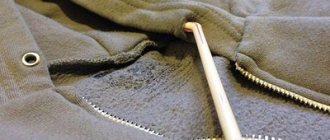08/31/201602.10.2020 Maria Ivanova
Have you taken up exercise or gone on a diet and lost weight? Have you had a baby and lost weight? You may be wondering how to wash a thing so that it shrinks? Each fabric has its own optimal temperature regime. When you turn up the temperature and then plunge things into ice water, most things will shrink.
Not everyone has the opportunity to completely update their wardrobe. In addition, woolen, cotton, and silk items shrink well after washing. Only polyester and other synthetics do not shrink.
Manufacturers write on the label at what temperature to wash this or that item. If it is not there, try to determine on your own what fabric the item is made of.
If that doesn’t work, ask the salesperson in the fabric sales department or atelier. Based on this knowledge, you can act by washing the item at a certain temperature so that a sweater, for example, made of wool, does not become dry.
When you wash linen and other fabrics, it is important to choose the right powder. It should be for colored things to make them even juicier. Then your clothes will not lose their former luster and will be like new.
- 1 Methods 1.1 Option No. 1
- 1.2 Option No. 2
- 1.3 Option No. 3
Methods
If you do not have the time or opportunity to read the entire article, watch the video on this topic:
Option #1
Let's consider it.
- Set the washing machine to exactly 60 degrees and wash your clothes.
- The spin mode should be standard.
- Let dry at the highest possible temperature. Of course, if your washing machine has such a mode.
Option No. 2
For example, you have a cotton dress and you have lost 1 size. Clothes can be made smaller by alternating high and low temperatures. If the clothes are clean, then the procedure can be carried out without powder.
The instructions include several steps.
- The dress should be soaked in water close to boiling water.
- After the water has cooled, you can wring out the item.
- Pour cold water with ice into a basin and throw the clothes in there.
- 20 minutes will pass, after which wring out the clothes a little and place them on a large towel (clean).
Do not throw synthetics or silk into boiling water.
Option #3
How to wash an item so that it fits 1 size? Modern irons have a device for releasing steam.
- Set your iron to maximum. Let it heat up.
- Iron, for example, a dress using steam.
Preparation
Before washing knitted items, you need to prepare them for cleaning:
- Place the product on a horizontal surface.
- Lightly work in the direction of the pile and against it with a comb (preferably wooden).
- Turn the clothes inside out.
This procedure will prevent pilling from appearing on clothes after washing.
Material Definition
Before washing, read the instructions on the product label. It indicates what material it is made of. The label also provides information about the washing and drying options for your pullover or sweater.
Checking the quality of coloring
In addition to the fact that knitted items stretch and shrink during the washing process, they can also shed. Due to the fact that it is not recommended to wash faded items in an automatic washing machine, it is necessary to check the quality of dyeing of the material.
Prepare a warm soapy solution. Soak your clothes in it for a few minutes. If the water stains, avoid machine washing.
Soak
Soaking is required for heavily soiled knitted items. Prepare a soap solution and soak the item in it for 1-2 hours. If you need to remove stains before cleaning, treat them with soap. Remove contaminants in accordance with their nature and the properties of the material.
Try to remove stains immediately after they appear. It can be difficult to remove a stain once it has dried.
- You can remove dirty marks from wool with salt.
- Wash cotton and viscose with a paste of soda and water. In addition, cotton items can withstand higher water temperatures.
- For light-colored knitwear, hydrogen peroxide and lemon juice are suitable.
- You can clean fur (natural) with semolina or sawdust with acetone. It is not recommended to wet items with fur (for example, fur collars). It is better to take them to a specialized laundry or dry cleaner. The same applies to knitted plush toys.
Basic principles of washing
Various types of natural and synthetic materials are used to make yarn. Each material requires special processing. Only in this way will products made from it be as comfortable as possible to wear.
Knitted items should be washed very carefully at low temperatures. They should not be twisted; excess water should be slightly squeezed out.
Significant damage to fabrics can occur when washed in hot water or ironed with hot steam. When washing wool, tencel, soy and bamboo fiber items, do not use fabric softener
Also handle washed items with care - lay them out on a flat surface and leave to dry
Materials and products made from them:
- Cotton. Do not wash cotton items at high temperatures, as they are prone to shrinkage. Saturated colors may lighten slightly at first. The material can be wrung out and ironed. It takes a relatively long time to dry. Cotton wears well and is suitable for allergy sufferers.
- Viscose. Do not wash viscose at high temperatures, do not wring, iron only with a damp cloth. The material dries well.
- Bamboo. Summer types of yarn can withstand machine washing and ironing with a damp cloth; they dry quickly. The fibers absorb 50% more moisture than cotton and have an antibacterial effect. Bamboo fiber clothing is great for allergy sufferers.
- Soy. Soy yarn can only be washed at low temperatures, do not wring or iron. It dries quickly. The material is characterized by high absorbency and antibacterial effect. Suitable for allergy sufferers.
- Tencel. Requires hand washing at low temperature. It is better not to iron the material. It is a cellulose fiber made from wood that has an antibacterial effect and excellent thermoregulatory properties, i.e. cools in summer and warms in winter.
- Wool. Woolen knitted items can only be washed at low temperatures, do not use fabric softener, do not wring, dry only on a flat surface, do not iron. Wool is a material that requires care, but is indispensable when making yarn.
- Synthetic fibers (polyester, polyamide (nylon), elastane, acrylic (polyacrylic), etc.). Synthetics can be washed in a washing machine and ironed with a damp cloth, also at low temperatures. It dries relatively quickly. It is recommended to use fabric softener. Items made from acrylic and other synthetic fibers are durable, wrinkle-resistant, generally very durable and affordable. In particular, acrylic fibers are more popular in combination with natural materials.
Washing woolen clothes
Read the label on how to properly wash wool clothes. Now do the opposite.
- For example, soak it in hot water for no more than 30 minutes. This may be 20 degrees more than what is written on the tag.
- Now rinse your clothes in cold water. You can even do it with ice.
- Take a large terry towel and wrap your clothes in it. This will remove excess moisture.
- It is forbidden to twist heavily woolen items.
- You need to dry it on a flat horizontal surface. It is very convenient to do this with a hairdryer, simultaneously giving the item the desired shape so that it does not stretch during the drying process.
Advice! If you need to make a wool hat a size or two smaller, then find a salad bowl of the required shape (round). Pull the hat over it and dry it with a hairdryer or leave it to dry naturally.
Woolen jackets and other items washed in a machine shrink greatly, but you cannot control the process. If your sweater is plain, you can set the “wool” mode and try it. And then dry as described above.
How to wash silk so that it shrinks
How to wash your favorite silk dress to make it shrink? The above tips are not relevant for shrinking a product made of natural, thin material.
Such things shrink and do not lose their shape only if certain conditions are met.
Remember them as an axiom:
- Correct temperature conditions. While with cotton and wool you can change the temperature in terms of temperature, with a silk product this is strictly prohibited.
- Hand wash only. What can you do to make your favorite silk sweater go down a size? In slightly heated water, 50-70°C degrees warmer than what is indicated on the tag, soak the clothes and add laundry detergent for delicate materials.
- Rinse in summer water.
- Leave the jacket or dress to dry in an open space (on the street or on a clothesline on the outside of the balcony). This is important, because silk needs flows of fresh and dry air to shrink.
Shrinking cotton
Need to shrink a cotton cardigan? This will work if it is sewn correctly. If the threads do not go as required, then nothing will work.
How to shrink a large cotton dress or suit? Experts recommend setting the machine to the hottest water possible with a strong spin. But you can only wash white clothes this way.
It is better to wash colored clothes by hand. Moreover, you need to remember the rule: when kept in boiling water for 5 minutes, the item decreases by 1 size. Accordingly, if you keep it in boiling water for 15 minutes, it will decrease by about 2-3 sizes.
After hand washing, it is advisable to use an electric dryer. If even after these actions the item has not decreased significantly, repeating the procedures is useless.
Nothing can be done. The clothes will remain the same size, but the structure of the fabric, especially colored ones, can be damaged by hot water.
How to iron woolen items
Usually, when drying properly, there is no need to iron. But if such a need arises, you must first of all find out the temperature of the iron indicated on the label. What to do in its absence is set out in the rules:
- Only completely dry items are ironed;
- the product is ironed from the inside out;
- To prevent shiny stripes from appearing, ironing should be done through moistened gauze or cotton cloth;
- The iron temperature setting indicator should be on the wool mark;
- To maintain its shape, you simply need to lower the iron onto the fabric without pulling it through.
We restore the heavily shrunken hem of the sweater by ironing it, after wetting this part.
Washing jeans
Regular denim items can be reduced by a size by washing them in very hot water. The fabric will fade a little and the water will turn blue or black, but this is not critical. But you won’t be able to shrink a stretch denim item. They even have a “shrink to fit” label on them.
When washing in a washing machine, set the temperature to between 60 and 90°C. The maximum spin is required. Drying can be done by machine, or simply hang things on a very hot radiator.
When washing by hand, alternate between very hot water and ice water. Then the thing will definitely decrease in size.
Unfortunately, jeans can become not only narrower, but also shorter. This nuance must be taken into account.
When does the wool “shrink”?
A material such as wool, due to its naturalness and natural characteristics, can easily be modified under the influence of various sources. First of all, woolen items shrink when washed at high temperatures . Natural hairs curl, compact and “fall off”, which makes the product warmer, but significantly reduces its size.
Important! Items containing both real wool and artificial fibers can behave completely differently. Some things containing synthetics do not shrink at all, some only stretch. Therefore, for products with a mixed composition, methods typical for natural woolen items may not always be suitable.
Washing linen
To reduce the size of the product, linen is washed by hand at 90°C. You can do this in an automatic machine if there is a special mode - “delicate wash”. Linen fabric will shrink 1 size after washing in hot water.
Read the powder label carefully. If the composition contains chlorine, detergents cannot be used. Otherwise, the linen will deteriorate and become discolored, and the linen will look sloppy.
You cannot use bleach (oxygen) if the linen has embroidery or colored material. But white or light-colored fabrics can be washed with this powder.
Washing linen will require a lot of water, since it is necessary to rinse the items thoroughly so that no detergent remains on them. Stains are also washed in the same way.
Advice! Don't want your colored linen item to fade? Set to 30-40°C for automatic washing or wash by hand. It’s especially disappointing when gorgeous embroidery fades.
Washing soiled woolen items
- Grease stains are removed using mustard powder. The product is prepared from 200 g of powder dissolved in water until a liquid consistency is formed, which is filtered through a layer of gauze and infused for 2 hours. When washing this way, the use of other detergents is undesirable.
- It is better to wash clothes of dark colors with mustard powder. A spoonful of vinegar added during the rinsing process fixes the color.
- To make the item soft after drying, add 1 teaspoon of ammonia per 10 liters of water during the rinsing process. To soften, you can also use glycerin in the proportion of 1 teaspoon per 5 liters of water.
Proper drying
How to reduce clothing size while drying? Many people simply do not understand that if done incorrectly at this stage of care, the sweater can become deformed, and it will be very difficult to return it to an attractive shape.
Dry a sweater made of natural wool to reduce its size, only in a horizontal position. The product is laid out on a terry towel or other hygroscopic material, giving it the desired shape.
How to make a sweater change size very quickly? During drying, you can spread the product, slightly squeezing it on all sides, near a radiator or other heating system. First, cover the battery with white paper and lay the sweater on top along with a towel. During such drying, the product will dry very quickly and decrease in size. To ensure even drying, you can periodically turn wool clothes over.
Important Tips
You can wash a sweater with shrinkage in the machine if you set the machine to spin. Wool is a very delicate material and therefore requires careful handling.
When washing, use special detergents for woolen products. Regular washing powder is not suitable for hand or machine washing. If you don’t have detergents for delicate materials in the house, and you don’t have time to buy them, you can wash the sweater with a small amount of mild shampoo.
Very often, individual parts of sweaters are pulled out: cuffs, collars, sleeves. You can reduce their size without a full wash. To do this, just moisten the elongated part with water from a spray bottle and lay the product on a towel to dry near the battery. In this case, the wetted parts must be squeezed with your hands, giving them the desired shape.
To prevent the product from acquiring an unpleasant odor during the drying process, it should be placed in a ventilated place, but away from direct sunlight. In addition, as soon as it gets wet, you can replace the towel on which the sweater is drying with a dry one.
Drying a sweater in the washing machine can also reduce the size. Therefore, for this purpose, you can safely use the additional mode.
To ensure quick and effective washing in cool water, do not use dry laundry detergent. It is better to buy gel-like products that dissolve easily in water and are also easy to rinse out of wool fibers.
Additional Tips
If you can still do something with clothes made from natural fibers to return them to their previous size, then it is almost impossible to make things made from synthetics look new after several washes and long-term wear.
In this regard, it is better to consult the dry cleaning staff. At least you can be sure of their professionalism. How to starch a napkin. Read how to wash a ballpoint pen from clothes here.
Find out how to remove pomegranate stains from clothes from the article:
Artificial fabrics such as polyester and nylon can also shrink, but for this you need to use additional tips when working with this material:
- you need to choose the right temperature mode and simply wash it in an automatic washing machine;
- water will help plant the item, in which the item should be soaked for a long time at low temperatures;
- if a problem arose with stretched clothing made of acrylic, lycra or spandex, then there can be no talk of any shrinkage; here you will have to contact the studio;
- after hand washing, it is better to dry clothes made of synthetic fibers on a radiator or in open sunlight;
- It is better to use a washing machine, selecting the “Cotton” mode when working at 60°C.
Rarely does anyone downsize clothing made from synthetic fibers. The question most often arises in relation to wool, since it is, so to speak, in the high-risk category. Knitted woolen items can stretch literally after the first wash if you miss an important point and start the wrong cycle. In addition, clothes made from natural materials are more expensive than those made from synthetics. It’s a pity to throw an expensive item in the trash or take it to the country.
Why shrink a knitted item?
The reasons why a knitted item needs to be shrunk are quite varied:
- it may be the wrong size - for example, a sweater bought without trying on turned out to be too big;
- it may be too thin - and shrinkage will slightly compact the product;
- mistakes may be made when washing and drying the product;
- it may stretch when used.
Most often, clothes have to be resuscitated precisely for the latter reason. Natural fabrics, in addition to all their undoubted advantages, also have a disadvantage - they easily stretch and lose their shape. It's a shame when your favorite thing suddenly turns into a shapeless, unevenly stretched bag. This is where our advice can come to the rescue.
What type of thread can be shrinked
But not every thing can be returned to its original form. It all depends on the type of thread from which it is made:
- Natural fabrics are most susceptible to stretching - and they also have a higher chance of shrinking back. Natural ones include wool, cotton, flax, bamboo, silk, nettle, hemp and other yarn made from fibers formed in nature;
The most famous natural threads for knitting are cotton, linen, wool, silk, bamboo - Clothing made from pure synthetics is very difficult to shrink, but it is also quite difficult to stretch it. The most famous synthetic types of yarn are acrylic, polyamide, lurex, nylon, lycra, polyester, microfiber;
- things made from mixed threads, that is, from a mixture of synthetics and natural fabric, can be shrinked, but a lot depends on the composition - which natural threads are included in the mixture and in what quantities;
- The greatest difficulties arise with things knitted from different types of threads - for example, wool and acrylic, or wool and cotton. If one of the types of threads is synthetic, then the shrinkage result will most likely be positive, since synthetics are difficult to change in size, so only the stretched part - made of natural threads - will shrink. If the entire product is made of natural fabrics, just of different types, then the result of shrinkage actions can be unpredictable, since each type of thread requires its own approach.
Before undertaking measures to return the item to its original form, the owner should immediately decide whether she is ready for the item to be damaged if the outcome is unfavorable.
How to make it fit the product in a specific place?
Getting something to shrink in the right place is a very difficult task, and with an unguaranteed result.
If the material can be processed with steam, then the following method is suitable:
- Water is poured into an iron with a steam generator.
- Set to maximum heat.
- When ironing, a jet of steam is directed to the place that requires shrinkage.
You can try to place the item in the right place using a hairdryer:
- wash the item or just wet it;
- spread on a horizontal surface;
- set the air regulator to hot air;
- directing a stream of heated air to the part of the item that requires shrinkage, try to gather it with your hands.
By exposing the entire thing to high or, conversely, low temperatures, you cannot be sure that the product will take the shape that is planned.











